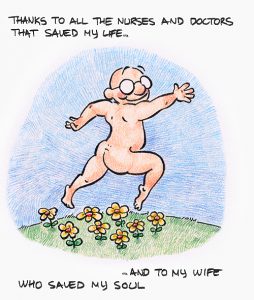In the spring of 2020, what seemed like a bad case of tendonitis turned out to be bone cancer in my left leg. Over the following months, I had to endure the full ordeal: chemotherapy, radiation, and finally surgery to replace my left knee, femur, and hip with a bone endoprosthesis.
I went from being a fully able and active person to becoming a passive one, forced to put my life on hold to be constantly treated, tested, poked, biopsied, infused and radiated.
I felt like a specimen in a test tube, entering a medical world that had been foreign to me until that point but, unfortunately, would become all too familiar for me and my loved ones pretty fast.
Even if I was alive I wasn’t living—I was being lived through. Life was happening in front of me, not to me.
And then, when I could no longer endure this submissiveness, I picked up a pencil and started to draw. It wasn’t a conscious decision; it was a survival reflex.
If I was being forced into the back seat of my own life, at the very least, I wouldn’t be a mere spectator—I would be a chronicler of what was happening to the person life had made me become, someone I barely recognized anymore. I started to tell my story in the form of a comic journal
Creating my ink-on-paper alter ego gave me a way to put some distance between myself and the ill person I had become. That distance made me sometimes to feel pity for that other person—the cursed one.
Every time I (and “him”) had to go through a bad episode, like not being able to go to the bathroom for thirteen straight days because of chemo side effects or having a panic attack inside the MRI machine, I would think of a joke and tell myself, “This is going to look great in the journal,” as I held back tears.
Then, after my second chemo treatment I started sharing my journal on social media, and I was surprised by how deeply it resonated with others—cancer patients, healthcare workers, and caretakers.They wrote to me to share how the journal made them laugh, cry, or helped them tell their own stories and feel seen With every new entry the community around the journal kept growing. It was no longer just about my journey; it became about everyone’s journey.
Every shared story was unique—cancer manifests in countless forms and pains—but there was so much we had in common.
Art, in all its creative forms, is a powerful tool for reclaiming life when you’ve been presumed dead.
For me, it was telling my cancer story in comic form. For Sam, it was expressing the pain of her brain tumor through poetry, even though she can barely read anymore. For Rita, it was making jewelry from the stones she collected on the beach—a beach that had witnessed her before and after she became a breast cancer survivor.
“A Brighter Tomorrow: Cancer and Beyond” show at the Gallery of ARTFul Medicine is a unique opportunity to demonstrate the importance of sharing our stories, which becomes vital when life suddenly turns your world upside down, making it hard to make sense of anything The empathy we receive from others becomes a lifeline, helping us recover a world that feels stolen from us.

